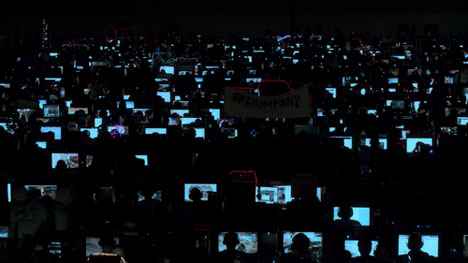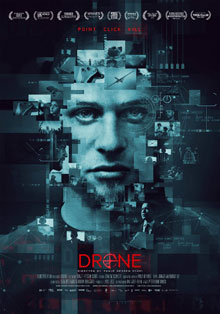 We live in the dawn of the drone. Amazon will soon be launching its Amazon Prime Air service, and self-confidently claims that in the future it will be just as normal to see parcel drones in the air as postal vans on the roads. At the beginning of August this year, as reported in Norwegian newspapers, Hanne Grotjord and her husband Torbjørn Jagland, former prime minister and long-time Nobel Peace Prize committee member, had the peace of their private life disturbed by a camera drone that hovered over their balcony in Risør. At a Sunday gathering with other creamed-rice-eating parents, I was recently told that the latest perk offered to workers by the major local employer was not a trip to the Go-Kart Club or access to a new ping-pong table, but a drone equipped with an advanced video camera. Hardly surprising, perhaps, considering that they’re already retailing for just 999 kroner (about 104 euros) at the local supermarket.
We live in the dawn of the drone. Amazon will soon be launching its Amazon Prime Air service, and self-confidently claims that in the future it will be just as normal to see parcel drones in the air as postal vans on the roads. At the beginning of August this year, as reported in Norwegian newspapers, Hanne Grotjord and her husband Torbjørn Jagland, former prime minister and long-time Nobel Peace Prize committee member, had the peace of their private life disturbed by a camera drone that hovered over their balcony in Risør. At a Sunday gathering with other creamed-rice-eating parents, I was recently told that the latest perk offered to workers by the major local employer was not a trip to the Go-Kart Club or access to a new ping-pong table, but a drone equipped with an advanced video camera. Hardly surprising, perhaps, considering that they’re already retailing for just 999 kroner (about 104 euros) at the local supermarket.
Like so many other civilian delights, from sticky tape to the Internet, the availability of drones is the result of intensive developments in military technology. If broadly defined as unmanned aerial vehicles (UAVs), they are far from being a new invention. It’s not uncommon to trace them back to Austria’s use of explosive-laden hot air balloons in the attack on Venice in 1849 – at the mercy of shifts in both wind direction and luck. Between the two world wars, the British Air Force developed the de Havilland Queen Bee, the first radio-controlled aircraft that could return to base and therefore be re-used. In the Vietnam War, drones gathered information for the Americans, and they were important for Israel during the invasion of Lebanon in 1982. Since 9/11, the production and use of drones has skyrocketed. With the development of advanced control, weapons and video technology can cover unlimited distances; the drone has gone from being a curiosity to creating a new paradigm in the way war is conducted. “It’s not science fiction. It’s what we do every day”, runs the slogan in the American Air Force recruitment video. Obama’s secret drone programme in countries like Pakistan and Yemen – “one of Washington’s worst-kept secrets” according to the New York Times – has placed the drone at the centre of public discussions. Critics fear that the threshold for states’ willingness to go to war is being lowered, while enthusiasts see them as the ideal realization of the generals’ age-old dream: attack without risk.
In the film industry, too, the drone has begun to make its presence felt, not just as a useful tool for filming – never before has it been so easy to film central Oslo from above at night-time to create an impression of pulsing city life tangled up with criminal affairs – but also owing to interest in drones themselves. Several critical documentaries have received massive press coverage, first and foremost Tonje Hessen Schei’s Drone (2014), which triumphantly did the rounds at film festivals throughout the world. It comes as no surprise that the high-tech drone has a special appeal on the movie screen. Surveillance suits visual media very well: just think of the balance of power that voyeurism has in thrillers from Hitchcock’s Rear Window (1954) via Coppola’s The Conversation (1974) to Tony Scott’s Enemy of the State (1998). What’s more, the drone is used in war and by intelligence agencies – sure-fire winners at the cinema, with or without troublesome moral dilemmas.
However, less literary attention has been lavished on drones, despite the ethical and political explosiveness of the phenomenon. A quick Google search reveals some American thrillers, including Richard A. Clarke’s Sting of the Drone (2014), which, according to the cover blurb, has done for the drone what Tom Clancy did for the U-boat. What Tom Clancy did for the U-boat I don’t know, but to the best of my knowledge there have been few literary efforts to deal with the drone outside the thriller genre. It was therefore something of an event when the author and media researcher Øyvind Vågnes published his fourth novel, Sone Z (“Zone Z”, Tiden, 2014) – possibly the first Norwegian drone novel.
Zone Z establishes a classic dystopian universe. Everything is apparently normal, but at the same time sterile. Early on, it is pointed out that the town in which the novel is set has no birds, perhaps because there’s something in the air that they’re averse to. The society depicted has a somewhat Orwellian feel, although its antiseptic cleanliness may make comparisons with Axel Jensen’s novel Epp (1965) more apt. The facades are smooth and cool, and instead of spontaneous activity, there is only predictable behaviour. Despite hints of inner turbulence and discontent, the main source of conflict in the country is the great wall along the coastline in Zone Z. Inside the walls, peace – if not contentment – reigns. It is this peace, or rather stability, that the protagonist, DeGarve, is charged with upholding. As an employee in the intelligence services of this unnamed country, his day-to-day – or night-to-night – job is to carry out surveillance on inhabitants and illegal immigrants with the help of drones.
The novel opens with the disappearance of DeGarve’s daughter, Lil. Given the situation, DeGarve is temporarily transferred to Zone B to take on easier assignments. The zones are divided like the growth rings of a tree, with levels of safety and wealth increasing the closer one gets to the core (Zone A). “Every zone called for its own temperament”, says one of DeGarve’s colleagues:
Everything you saw, you saw through the sights. That’s the way it was in all the zones. But in Zone B, your pulse didn’t quicken when you were taking your bearings like this. An operator in Z was more like a hunter. You developed your own gaze as you floated above the wall. As if you were searching for wild game with night vision binoculars.
From being a hunter who protects the territory from external “threats” (that is, refugees), DeGarve must shift the focus of his surveillance towards fellow citizens and fight a battle against boredom: “Little or nothing happens under our aircraft down there in the affluent zone.” During a shift in Zone B, his boss Clemet appears with a new employee, giving rise to an effective if somewhat formulaic means of familiarizing the reader with the intelligence service’s mentality and development. In a speech about the informal rules “that aren’t in the instruction manuals”, Clemet contentedly informs the employee about the increased flexibility of the intelligence services. He recalls with a shudder the bureaucratic past, when “the guidelines for the urban space zones were clear. Sharp, restricted. The processes were to be rendered transparent. In logs and protocols. A reason had to be given for everything you did. There were good grounds for suspicion.” With the bombing of a purification plant, practices changed, presumably owing to the “clean-up that followed” this terrorist act.
It is a well-known phenomenon that a terrorist attack can alter the rules of the game, along with the balance between the realm of democratic processes on the one hand, and that of the secret services on the other. The responsibility of the US Air Force for carrying out the CIA’s drone programme offers a particularly controversial recent example of this phenomenon. When the novel talks about the monument commemorating the purification plant incident, it’s easy to think of Ground Zero in New York: the bereaved can go there with their grief, while the intelligence services deal with the fear that it might happen again: “We get to take care of that”, as Clement says in classic bad-guy fashion. The fear of new attacks increases acceptance of preventative measures.
In the Steven Spielberg film Minority Report (2002), based on the 1956 short story of the same name by Philip K. Dick, this is taken to its furthest logical extreme. With the help of so-called “precogs” – psychics who are hooked up to a computer that visualizes future scenarios – the police can simply see into the future and stop crimes before they happen: detectives now investigate the future rather than the past. A similar pipe dream is expressed by Andy von Flotow, director and founder of INSITU, a real-life company that produces a substantial share of the US Air Force’s drones. In Hessen Schei’s documentary, Drone, von Flotow nonchalantly expresses his vision: “I hope the assassinations become so targeted that the individuals who engage in instigating warfare die before they have a chance to finish their instigation.” He was not, presumably, referring to his own government, but to potential rebels in countries such as Pakistan and Afghanistan.
Zone Z has no clairvoyant precogs – as this futuristic novel falls into the category of near future science fiction, where little or nothing differs from our current technological possibilities. But the intelligence services in the novel share the same dream as the authorities in Minority Report and von Flotow: to uproot evil before it happens. Clemet presents his vision thus:
It was when [the purification plant was blown up] that they understood it, he said. That to prevent catastrophe, you have get in there earlier. You have to get in there when the thought is taking shape. When the ideas are unfolding. When everything is in incubation. When plans are materializing. You have to get in there at the living room table, in a flat some place or another out in Zone D or E, where some people are gathered. Where the bomb is mentioned for the first time. Long before it explodes on a street corner in Zone B. Because by then it’s too late.
The aim is to nip things in the bud before they reach full bloom. Nonetheless, the fear of terror alone is not enough to explain the increased surveillance – either in Zone Z or our own everyday lives. The changes can be blamed on the new possibilities arising from technological development:
Before, we followed an individual, said Clemet. That’s my point. We followed a person and we based it on a suspicion. Now we look at everything, all the time. Because we can. The means have defined a new end.
Clemet’s introductory speech may feel somewhat formulaic and over-explanatory, but it also reveals the conceptual substance of the novel: how are technological changes interwoven with mental changes, and how do they shift the boundaries of what is acceptable? And why has total surveillance become the norm? “Because we can”, says Clemet.
Beyond dealing with surveillance in general, the most important theme in Zone Z is the arrival of the armed drones. The activities by the wall in the outer zone are of decisive significance. In this area, the drones carry missiles that the operator is authorized to fire if he deems it necessary to do so. Killer drones are also the central concern of Théorie du drone (2013) by the French philosopher Grégoire Chamayou, which recently came out in English under the title A Theory of the Drone (The New Press, 2014 – also published by Penguin as Drone Theory). Here, Chamayou discusses the ethical and political consequences drone warfare can have for the individuals who carry out the attacks, for the military system and its self-perception, for the victims and for civil society’s view of warfare.
The book’s approach is influenced by the French-Jewish mystic and Marxist philosopher, Simone Weil (1909-1943), who claimed that it’s a dangerous blind alley to analyse warfare and military violence on the basis of its ends: the essence of her materialistic method, she writes, is that it “attaches much less importance to the ends pursued than to the consequences necessarily implied by the working out of the means employed.” Weil is therefore less interested in how the ends justify the means. Instead, she is investigating how the means themselves contribute to creating new ends. Although Weil is only mentioned in passing in Chamayou’s introduction, it is this attitude that guides his critique. Far from being philosophical sophistry without any practical significance, this perspective allows Chamayou to address the (new) ends that drone technology engenders.
In Clemet’s speech, cited above, this is clearly spelled out in an unabashed and self-congratulatory tone: “The means have defined a new end.” Here he is talking about the shift to the comprehensive surveillance of his own citizens, “from conducting surveillance on some to monitoring everybody” – this informs the way in which the border controls function in Zone Z, as a result of which it’s considered legitimate to eliminate unwelcome intruders without warning. If we apply Chamayou’s perspective to Obama’s secret drone programme against people who are suspected of potentially committing terrorist acts, we can ask: how far would the American intelligence services have gone in the war against terror and how actively would they have intervened in far-flung areas if drone technologies were not available? What began as a reaction to the events of 9/11 appears to have transformed into a permanent war against those who are perceived as being inclined to undertake terrorist acts in the future – even if they are in a country that isn’t formally engaged in armed conflict; indeed, even in countries that are US allies. True, president Obama indicated a change when, in 2013, he declared that “the war on terror” – launched by George W. Bush on 20 September 2001 – was over. Instead, the Obama administration would emphasize specific attacks directed at individual groups that represented a threat to the United States; however, as Hessen Schei’s documentary testifies, this had rhetorical rather than practical consequences.
This is a sore point for the United State’s official foreign policy. It’s one thing for the country to have been formally at war with Iraq from 2003 to 2011 and to have been at war with Afghanistan since 2001. On controversial grounds, true, but nonetheless: at war. Worse, though, is that the country is carrying out a series of drone attacks in other areas too, perhaps the most hotly debated case being Waziristan, in northwest Pakistan on the border with Afghanistan. Hessen Schei’s documentary follows the efforts of a Pakistani lawyer and a British human rights lawyer to mount a court case against CIA representatives in Pakistan who are responsible for the drone attacks in the region. It seems unthinkable that the USA could go to war against its ally, Pakistan, but at the same time, systematic and badly concealed drone attacks are being carried out against local people who are allegedly terrorists. And these attacks may be based less on who the targets are than on what they are doing: the simple fact of being a group of young, bearded men with machine guns may be enough. Spencer Ackerman in The Guardian describes the procedure thus: “The Obama administration considers the real alternatives to drone strikes to be the unpalatable options of gruelling ground wars or passive acceptance of terrorism. Then it congratulates itself for picking the wise, ethical and responsible choice of killing people without knowing who they are.”
In a situation like this, where war is unthinkable but at the same time, attacks are being carried out regularly, Chamayou’s Weilian thinking about what actions might be engendered by new means is enlightening. If the choice is between drone attacks and no action – traditional military interventions would have had high economic, political and diplomatic costs – the drone attack appears to be the lesser evil. Chamayou warns against this way of thinking with a quotation from Hannah Arendt: “Politically, the weakness of the argument has always been that those who choose the lesser evil forget very quickly that they chose evil.”
Two justifications frequently make an appearance when advocates of drones wish to portray them as the lesser evil or – in the case of the most outspoken – as a “humanitarian” advance. The first – and the most obvious – is that soldiers’ lives are spared: if we have to take out our opponents in any event, it is naturally best to do it without being exposed to danger ourselves. It is generally pointed out that this has always been an end: “The ambition of being able to take life at a distance has been a hallmark of the entire development of military technology. Spears, guns, bombers and missiles were all developed with this end in mind”, write Andreas Brekke Carlsson, Camilla Serck-Hansen and Jacob Thomas Staib, all attached to the ethical council for the defence sector, in their article “War by remote control – drones and the ethics of war” in Nytt Norsk Tidsskrift 1/2015 (“New Norwegian Review”). The second justification relates to the victims themselves: the drone’s high precision, based on lengthy information-gathering about the supposed terrorists – not to mention the precision of the drop itself – makes it more accurate than the traditional bomber plane, in which the risk of striking civilians is much greater.
This notion of the drones’ lesser evil is a utilitarian’s wet dream, seemingly tailor-made as a thrilling dilemma for fledgling philosophy students: if A, by killing B, saves C and D, should he kill B? Let the debate begin. The justification of the drone pilot’s liquidations on the basis of the action the victim may have planned to carry out (possibly against American citizens) has a central place in several of the more recent films about the everyday life of American drone operators. In Andrew Niccol’s drama Good Kill (2014), the CIA takes control of the Air Force’s operations, which go from being fully logged military attacks to off-the-record elements of the intelligence agency’s services. The recording device is switched off and the order is clear: “Nothing you do has happened.” The protagonist, Thomas Egan (played by Ethan Hawke), finds his objections growing as it gradually emerges that the agents at Langley give little consideration to any civilians who might be in the vicinity. The balance sheet, which is never shown to the drone pilots, apparently always comes out positive: “In our judgement, the greater risk is to do nothing.” Martin Luther King’s famous words – that the greatest problem is good people’s indifference, not evil people’s actions – are given a perversely Manichean twist here: we are good and therefore our actions are also good. What’s more, the lack of transparency embedded in the nature of the CIA and other intelligence services destroys the chain of responsibility – for who can be made responsible for potential war crimes when the decisions are taken in secret? “Did we just commit a war crime, sir?” asks one of the pilots on the base. No response.
*
One of the most pressing questions raised by drones concerns the effect of the increased distance between the drone pilot and the victim. It is no secret that American drone pilots generally sit in a bunker at Creech Air Force Base in the Nevada Desert, a mere hour’s drive from Las Vegas, where they work in shifts, monitoring the images relayed by the drones on screens. Does this distance make it easier to take a life than if one were face to face with the enemy somewhere in the Middle East – and if so, is this a problem? Not necessarily, according to the article by the defence ethics troika in Nytt Norsk Tidsskrift, which discusses whether “there is anything about drone technology that makes the operator more inclined to make decisions that violate the principle of discrimination”. The principle of discrimination, along with the principle of proportionality, is one of the main rules of the so-called “law of war” tradition (jus in bello), and requiring that any use of violence in war must spare civilians in so far as it is possible. But after airing their objections to the notion that physical proximity creates a greater unwillingness to take innocent lives, the trio write the following: “The distance between the operator and the target is, however, not necessarily a hindrance to the discrimination principle. The distance can contribute to a greater degree of objectivity.” Here it is assumed that drone pilots will not let themselves be carried away by the adrenaline of war or the desire for revenge, since their lives are not in danger; they can therefore make decisions more objectively, based on the conventions of war that preserve the distinction between acceptable and unacceptable killing.

Still from
The distance between operator and target has led other critics to fear a “Playstation mentality” taking hold among the drone pilots, resulting in a weakened ability to grasp that one’s actions affect flesh-and-blood human beings. Two human rights lawyers are cited on this point in the NNT article: “Young military personnel raised on a diet of video games now kill real people remotely using joysticks. Far removed from the human consequences of their actions, how will this generation of fighters value the right to life?” According to this reasoning, the transition from the computer to the control room joystick is so slight that, psychologically speaking, it makes it too easy to kill. In part this concern is rejected by the authors of the Nytt Norsk Tidsskrift article: first, in many cases it can be a good thing that it is easier to take lives, as long as the attack is legitimate and in line with the conventions of warfare. Second, research shows that drone pilots also suffer from post-traumatic stress disorder (PTSD), and this indicates that they are not as unaffected by their actions as one might fear.
Irrespective of whether or not drone operators do indeed have problems distinguishing between real and virtual enemies, it is a fact that the United States Department of Defense has developed its own computer game as part of its recruitment efforts. Hessen Schei’s documentary contains a scene in which thousands of teenage boys sit busy with war games at a gaming convention while an elderly colonel observes the whole thing. Is this where the future air force fighters are to be found? In a kind of “revenge of the nerds”, as a former pilot in the film calls it?
How does it feel to kill in this way, when your motor actions and your image of the situation are so reminiscent of computer gaming? What does it do to the “pilot”? Rick Rosenthal’s unsophisticated but nonetheless hair-raising film Drones (2013) deals with this issue in an unsubtle fashion. Two drone operators, Jack and Sue, are sitting waiting for a so-called HVT (High-Value Target) who is supposed to be eliminated in Afghanistan. Jack has been recruited for his computer gaming skills and his main piece of advice for his newly hired colleague is not to think too much, because he admits that the work “gives you weird fucking dreams”. The protracted spell of surveillance is interspersed with video games displayed on the same screens, apparently an obligatory part of the training. Even though Sue is new, she represents traditional military values, and is therefore highly critical of the mission: “It’s like stepping on an ant.” In a heated moment, where they come close to taking the life of an innocent civilian, Sue shouts out desperately: “I’ve studied the history of warfare for four years, but no war I’ve read about is like this one!” Jack replies: “Perhaps you shouldn’t have read so much – perhaps you should have played video games?”
What Sue in Drones, Thomas Egan in Good Kill and DeGarve in Zone Z all have in common is that they have previously been fighter pilots, or wanted to be one. They are transitional figures, with one foot planted in a traditional military perception of the self – where the notion of exposing oneself to danger is taken for granted – and the other in our post-heroic drone era, where risk is eliminated. At their respective workplaces, they belong to the minority that actually have pilot training – the majority of those around DeGarve are “trained on simulators”. This mirrors the situation in the USA today, where more drone pilots are being trained than fighter and bomber pilots combined. This is also a source of concern in defence circles, where many fear a crisis in a military ethos that has traditionally assigned a high value to courage and self-sacrifice. DeGarve touches on these kinds of thoughts in a flashback: “To fly was to expose oneself to danger. Oneself and others. It involved a hubris that had a certain beauty to it.” Egan says in Good Kill: “I miss the fear. You’re up in the sky, something can happen, there’s risk, you know.” Sue cannot fly because of an eye injury and the fact that she is completely safe in Nevada prompts a certain self-contempt when she compares herself to the enemy: “At least he’s willing to die for what he believes in!” There is obviously much that is problematic in DeGarve’s attitude, which should not be confused with that of the novel itself: aestheticizing traditional warfare is hardly the way to approach a critique of drones. But in psychological terms, the glorification of danger by all these characters highlights a desire to escape the numbness created by their current work.
Do drone pilots actually become ill as a result of their work? In order to answer this question, both critics and apologists point to studies of the psychological after-effects operators can suffer as a result of their work. Chamayou claims that interest in drone pilot trauma has only arisen in recent years, in line with growing media attention. In the early 2000s, there were many interviews with drone pilots who actually described their actions as “a gamer’s delight”, or as one pilot cited in Theory of the Drone puts it: “It’s like a video game. It can get a little bloodthirsty. But it’s fucking cool.” Chamayou traces a shift in the rhetoric, from those involved pointing out the similarity with video games to their saying: “We are not just playing video games here”, as quoted in a 2012 interview in the New York Times.
Chamayou thinks this change is largely the effect of pro-drone PR efforts to offset the public relations disasters provoked by such media stories: “Press officers must have reframed their aim and re-briefed the troops, for nowadays there is no longer any sign of such statements in their interviews.” The image of a cold, unfeeling Nintendo warrior is hardly confidence inspiring. “If they felt nothing at all, this would create a moral problem. But given that they kill with sensitivity and even with ‘care’, they can continue to do so with our blessing.” This leads to a paradox in the military system. Traditionally the army has made a deliberate effort to ensure that soldiers are capable of killing in a legitimate war situation, and therefore to wear down any interpersonal objections a given individual might have. In this asymmetrical drone war it is, on the contrary, necessary to demonstrate that there’s a human face inside the container in the Nevada desert: this man may take lives without danger to his own, but don’t go thinking he does so lightly! For Chamayou, matters become even more perverse when the possible after-effects (such as PTSD) are used as an excuse to highlight the soldiers’ courage. Traditionally, it is pacifists who have pointed to the mental burdens of war in order to highlight war’s human costs, even after it is over. But here, the argument undergoes an Orwellian twist, so that the warriors’ psychopathologies become proof of their willingness to sacrifice themselves: they are no longer exposing themselves to physical danger, but they are risking mental problems and therefore deserve a medal.
What category does DeGarve fall into, in that case? Is he a Nintendo warrior or a bundle of nerves haunted by his conscience? He is perceived as a “legend” by colleagues and superiors at his workplace, the one who keeps it together when others fall apart. Perhaps it is possible to see DeGarve’s past as a pilot as a reason for his dawning aversion to his work, but it’s unclear whether this plays a central role. Rather, it is a conversation with his daughter, before she vanishes, that awakens his gnawing conscience: “Do you ever think about them, she said. About the people there by the wall.” He tries to answer half-heartedly that he’s just doing his job, but the conversation closes without any reconciliation and plants a nagging doubt.
After this, DeGarve is no longer able to view the refugees as an undifferentiated mass; they emerge as individuals: “Some place or another along the way, they had gained clear features. He understood, of course, that his imagination was playing tricks on him, but that didn’t help. It had become possible to distinguish them from one another, they were all people with their own characteristics.” He begins to be haunted by the “white shadows” he observes in the heat-seeking camera and to suffer from lack of sleep. A similar motif can be found in the short film Drone, by Justin S. Lee (2015). A newly trained drone pilot is going to carry out his first mission. The screens switch between normal film and a heat-seeking camera, so that the terrorist who is playing with his son is fully visible one moment and is just a white shadow moving on the screen the next. When the more experienced colleague beside him sees that the newcomer is struggling with his conscience, he says: “It’s just a white duck, remember?” and switches back to the heat-seeking screen.
This emphasizes another characteristic of the drone’s distance: one is both near and far at the same time. By comparison with the bomber plane, for example, the drone pilots can develop a more intimate knowledge of the people they will later execute, since they may follow them for weeks, become familiar with their habits, friends and families. Despite the asymmetry, this can create compassion – an emotional connection that one would not necessarily have in the field. And when, in addition, these people do not constitute any acute danger for you or yours, it can easily seem cruel to kill them. Of all the books and films discussed here, the short film Drone (2013) by Daniel Jewel is the only one not to dwell on the drone pilot’s emotional conflict. (The lack of creativity in the choice of names for films about drones – Drone (2013), Drones (2013), Drone (2014), Drone (2015) – probably testifies to the appeal of this topic.) Here, the pilot simply gets up, drives to work, finds his selected target on his computer, blows him to pieces and buys a coffee at the drinks machine before his colleagues turn up one after the other, ready to do more of the same. Owing to the indifference and automation, as well as the fact that the work is carried out in suits, in a normal office setting, the silent short bears some resemblance to the work of the Norwegian contemporary artist, Pushwagner: neither feelings nor thoughts exist, just goal-oriented behaviour. The absence of objections becomes so conspicuous that the film’s topic is this absence more than anything else.
In DeGarve’s case, the objections aren’t entirely washed away. This is not to say that he begins to ask questions about what he’s doing – DeGarve is as good as free of any moral and political reflections related to his work. Torgeir Mortensen, writing in Universitas, sees this as a great weakness in his pointed review, “Zone Zzzzz” (19/10/2014).
The greatest disappointment, in any case, is that DeGarve doesn’t reflect upon the obvious moral issues he encounters in his job. Other than entirely superficially. His excuse is as simple as it is unoriginal: He’s not the one who makes the decisions. […] Hannah Arendt’s thesis about the banality of evil has never seemed so uninspired as in DeGarve’s world.
Admittedly, Mortensen’s objections are quite right to some extent; there is something predictable and a little clumsy about DeGarve’s “I’m only doing my job”. At the same time, I find this well-written review unreasonable in demanding a higher level of reflection from the protagonist. Vågnes obviously has no intention of letting DeGarve share his experiences in the essay “The white shadows” in the next issue of an intellectual review, but is rather attempting to show how the catch has somatic consequences in the form of sweating, trembling and insomnia. And that this is held in check by using prescription pills, in the same way that Good Kill‘s Thomas Egan drinks more and more to maintain a distance between his drone activities and his private life.
Towards the end of the novel, DeGarve embarks on a romance with a woman he previously had under surveillance. He is hopeful, and any longing for contact with his daughter appears notably absent in the now newly enamoured middle-aged man, who sees this love affair as an opportunity to leave his past actions behind him – without any real reckoning – and to become a new person. “A new chronology, almost” he thinks after their first tryst, but it is ultimately only almost. Symptomatically enough, it is also here, in the novel’s last 15 pages, that we learn DeGarve’s first name is Thomas, and that the woman is called Eva. These names stand out as more recognizable and perhaps intimate than the novel’s other names, which have a kind of colonial, Afrikaans ring to them: Witleth, Wahl, Seeberg, Moot, Vincents, Trellé. The revelation of the name not only creates intimacy but also foreshadows Thomas DeGarve’s possible baptism as an exonerated man – at least in his own eyes.
DeGarve’s eyes are central to the novel: it is often noted that they are red, irritated and swollen. It’s no wonder that a man who is so heavily reliant on his eyes in his work should suffer a certain amount of wear and tear, but there is also an obvious metaphorical value to this point: his eyes are marked by what they have seen. In the final scene, Eva takes action and gives him eye-drops, with the meaningful comment: “That’ll wash you clean.” Eva doesn’t know about DeGarve’s past and in his efforts to impress her, he has entangled himself in a series of spellbinding lies that he almost seems to believe himself. Given the knowledge that DeGarve previously had Eva under surveillance, Eva’s cleansing of Thomas doesn’t strike one as any great purification. The book closes with DeGarve standing on the edge of the block’s roof terrace, “wingless”, and this is apparently the last thing he does: “He could hear a siren, but the sound lost itself in the darkness until all he could hear was the wind.”
DeGarve’s possible suicide underscores the question: who do I become when I control a killing drone? This is scarcely touched on in the analysis of Serck-Hansen et al. in Nytt Norsk Tidsskrift, but is crucial for Chamayou. Since Chamayou is not entirely convinced that post-traumatic stress is an appropriate diagnosis for drone pilots, the French philosopher suggests that we should, instead, investigate whether this existence produces divided psyches, in other words a form of compartmentalization. Is this where we should search for tomorrow’s military virtues, asks Chamayou; in the capacity to “set aside” and thus move effortlessly between the morning’s executions and the afternoon’s family fun? This contrast appears frequently in the discussion of drones, and it is difficult to avoid the points made about the short distance between Creech Air Force Base and Las Vegas, or between Creech and the suburbs. The films also know how to exploit this slightly absurd seamlessness: “You just gotta keep compartmentalizing”, says Egan’s boss in Good Kill. “And never mind if the compartments get too close.”
What at first appears to be the best of both worlds – one moment you can kill some bad guys, the next you can order pizza, as they say in Drones, or you can combine “battlefield and blackjack”, as in Good Kill – gradually becomes a nightmare situation, in which the war seeps into one’s private life and vice versa. In DeGarve’s case, the compartmentalization has worked pretty well for a long time, even though he knows he has the blood of innocent people on his hands, but towards the end, his mental defences look as if they have broken down – as a return of what has been repressed. “You’re not supposed to endure everything”, his ex-wife says earlier in the novel, and in the end DeGarve doesn’t. Somewhat belatedly, he comes to a similar realization as the former drone pilot and whistle-blower Brandon Bryant in Hessen Schei’s documentary: “The image of my soul was cracking, and breaking apart.” Thomas Egan smashes a mirror in anger at the end of the film, to see his own splintered reflection staring back. DeGarve’s effort to do good – to restore his self-image – consists of not reporting a horde of refugees tunnelling under the wall on his last shift.
The lining walls of the compartments therefore break for DeGarve, and in fact this is the source of hope in the novel: it is precisely human “weakness” – compassion, doubt, insight – that makes it possible to combat the drones’ dehumanizing effects. Despite the computer game quality of the attacks, it does cost the pilot something to have deadly power over other people – that is the attitude one finds in these films and in Vågnes’s novel. Naturally, they are quite within their rights to have that opinion, since cases such as Brandon Bryant’s provide support for them. At the same time, though, Bryant points out in the documentary that he is the only one among his many colleagues who is actually talking about what has happened and continues to happen (since then, others have also come forward). He belongs, in other words, to the tiny minority of deserters who are protesting against the system. The majority of drone pilots continue to carry out their tasks, and possibly the effects are not as great for them – perhaps the distance does in fact have an alleviating effect and set up an effective moral buffer so that they can live their lives as normal. The percentage of drone pilots with post-traumatic stress disorder is, in fact, lower than in the American population as a whole, Chamayou notes. The military psychologist Hugo Ortega claims in a report that the unease experienced by drone pilots is essentially reminiscent of that experienced by others in tough professions: “If you look at nurses who work night shift, anybody who does shift work, they complain of the same things” (quoted by Chamayou).
Perhaps the most serious problem with drones is not, then, the state of mind they create in their operators – although that is, of course, important enough. The problem lies in the elimination of the difference between war and peace: what was once a war that ended at a given point in time is now a never-ending police action – the difference being that this police force is not subject to common law. No prisoners are taken, you are guilty until proven innocent and by that time you may well already be dead. How did it become like this? Because it is possible, is perhaps the banal and correct answer. This change is not dealt with by the defence department’s ethical council in the NNT article. Their desire for a principle-based ethical discussion detached from the factual circumstances means that they end up with an isolated analysis of the drone’s means of achieving military objectives, which fails to reflect how military ends are being shifted by drone technology. Strikingly enough, Brekke Carlsson, Serck-Hansen and Staib use examples from drone strikes in Pakistan when they talk about the loss of civilian life during warfare without specifying that the USA and Pakistan are allies. It is precisely this blind spot that Chamayou is attempting to render visible: the confusion between military and civilian violence; the fact that the attacks are sanctioned by the highest authority, in secret, without taking a detour via soldiers recruited among one’s own citizens who might ask questions about the need for this attack: is it worth risking one’s life for this?
Soon there will probably be drones the size of bees, equipped with cameras and deadly poison. Then, perhaps, the drone supporters’ claims about “surgical precision” will finally come true – but at what price? How many executed enemies will it take for one to feel safe? All of them? Who are they all? Will we be safe then?
The English translation was funded by Fritt Ord.









